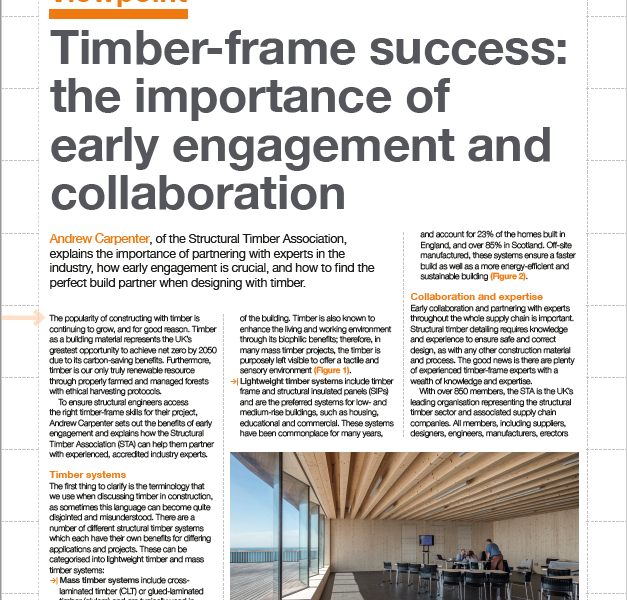Timber Frame Success: The Importance of Early Engagement and Collaboration
16/05/2023

The popularity of constructing with timber is continuing to grow, and for good reason. Timber as a building material represents the UK’s greatest opportunity in achieving net zero by 2050 due to its carbon saving benefits. Furthermore, timber is our only truly renewable resource through properly farmed and managed forests with ethical harvesting protocols. To ensure structural engineers access the right timber frame skills for their project, Andrew Carpenter, of the Structural Timber Association (STA), explains the importance of partnering with experts in the industry, how early engagement is crucial, and how to find the perfect build partner.
The first thing to clarify is the terminology that we use when discussing timber in construction, as sometimes this language can become quite disjointed and misunderstood. There are a number of different structural timber systems which have their own benefits for differing applications and projects, and these can be categorised into Lightweight Timber and Mass Timber Systems:
- Mass timber systems are cross-laminated timber (CLT), or glued-laminated timber (Glulam), and are typically used in complex and high-rise buildings. The use of mass timber for these types of buildings presents a great opportunity for reducing the carbon impact of a building both during construction and throughout the lifetime of the building. Timber is also known to enhance the living and working environment through its biophilic benefits, therefore in many mass timber projects, the timber is purposely left visible to offer a tactile and sensory environment.
- Lightweight timber systems include timber frame and structural insulated panels (SIPs) and are the preferred systems for low and medium-rise buildings, such as housing, education and commercial. These systems have been commonplace for many years, and account for 23% of the homes built in England, and over 85% in Scotland. Offsite manufactured, these systems ensure a faster build as well as a more energy efficient and sustainable building.
Early collaboration and partnering with experts throughout the whole supply chain is important. Structural timber detailing requires knowledge and experience to ensure safe and correct design as with any other construction materials and process. The good news is there are plenty of experienced timber frame experts with a wealth of knowledge and expertise.
With over 850 members, the Structural Timber Association is the UK’s leading organisation representing the structural timber sector and associated supply chain companies. All members, including suppliers, designers, engineers, manufacturers, erectors, and installers are profiled on our website.
It is important that quality and standards of timber construction must be to the highest degree; therefore, the STA see that accreditation is crucial to providing all stakeholders with evidence that companies are held to high standards.
The STA’s Quality Assurance Scheme STA Assure scheme provides solid reassurances to the construction community that members meet or exceed current legislation and regulatory requirements. The robust assessment process ensures that design, production, and site assembly processes and quality controls are in line with customers’ expectations for consistent, high levels of quality. Another vital note is that for members to attain STA Assure accreditation, the installers that they contract with must have successfully completed the STA’s Timber Frame Competency Award Scheme (TFCAS), an invigilated test to ensure competency and knowledge.
The importance of making early engagement with contractors, architects, and other partners cannot be overstated. In the same way as any other construction system, in order to construct an efficient timber building, material choice should be made at the early stages of design stage. This material-first approach should be best practice across the industry.
Read full article here